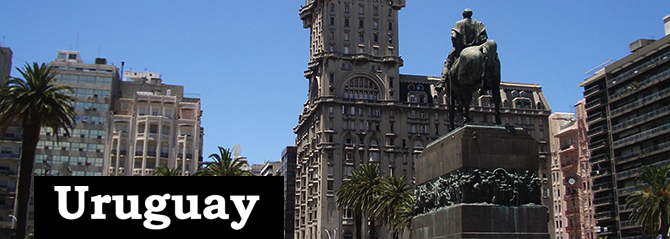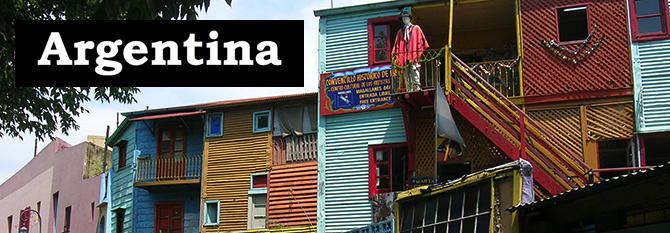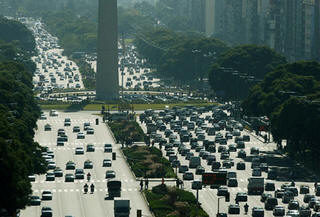|
|
Dec 21, 2005 - Jan 12, 2006 Colonia de Sacramento - Nueva Helvecia - Kiyu - Montevideo (Uruguay) - Buenos Aires (Argentina) |
|
 |
|
|
Our longing for a good auld Swiss roesti (potato pancake) brought us to this totally unremarkable Swiss colony: Nueva Helvecia. Dating back to the 1800s, this sleepy, rural settlement is the centre for cheese and milk production in Uruguay. Our arrival on the packed bikes was probably the highlight of the day, and before the dust had settled, we were flagged down and interviewed by the regional radio reporter. Kurt spoke Spanish with his hands and feet... and it's anyone's guess how that was transmitted over the radio waves! |
|
|
|
|
| To break the journey to Montevideo, we camped on a beautiful white sand beach at Kiyu, on the Río de la Plata (Plate River). 80km wide, this river appears like a sea, with waves, and a great grey mass stretching to the horizon. A grand place to wake up on Christmas morning. |
|
| Uruguay's capital, Montevideo, is home to half the country's population. It's one and a half million get to enjoy a long, sandy coastline and a wonderful historical centre with fabulous buildings, monuments and plazas from the 19th century. Artigas, the local liberator, occupies a prime spot in the Plaza Independencia. | |
|
|
|
| Plaza Independencia |
Ministery of Foreign Affairs |
| Tango is almost as popular in Montevideo as in Buenos Aires. The locals take great pride in the fact that tango’s all time hero, Carlos Gardel, was born in Uruguay. | |
|
|
|
 |
|
| After seeing all of Uruguay’s cute small towns, Montevideo seemed like a
metropolis… until we hit
Buenos Aires.
What a city! It’s the most European we’ve seen in Latin America so far.
Buenos Aires’ broad boulevards, stately buildings, shady plazas, spacious
parks, inviting cafés and restaurants, as well as numerous galleries,
museums and theatres make it a happening, exciting and delightful city.
This city of 8 million has many centres, all with their own flavour and
character, which made our two-week stay quite diverse. Plaza de Mayo is one of the historical centres where there are daily demonstrations in front of the presidential offices in the Casa Rosada. |
|
|
It is here that the “mothers of the disappeared” have been meeting for 25 years to protest against the atrocities of the military dictatorship. U2's final track on their Joshua Tree album is a must at every Argentine concert, and indeed in many other Latin American countries with similar political tragedies. |
|
|
Recoleta cemetery |
Recoleta is known for its luxurious mansions and numerous galleries, but most of all its impressive cemetery. This final resting place for the famous and not so famous has become an open-air museum. Father Fahy, an Irish priest who initiated the wave of Irish immigration from the midlands in the late 1800s, lies among presidents, generals, sports personalities and Argentina’s own Evita. |
|
A lot more colourful than the dead centre is the famous Caminito street at La Boca. In the 1950s, when the train line to this port ceased to function, the houses became deserted and quite drab. Local artist, Quinquela Martín came up with the idea of painting the houses in primary colours to bring some life back to the neighbourhood. Now tourists and screeching tango vocalists have followed making it a loud, commercial circus with a picturesque background. |
|
|
|
|
| Caminito, La Boca | |
|
Calatrava's Lady's Bridge |
Puerto Madero of the 19th century was not very successful as a harbour, but as a city development site its present appearance adds another pleasant aspect to Buenos Aires. Its red-brick warehouses on the docks of the Río de la Plata now house up-market restaurants, cafés and apartments for the affluent sector of society. Our old friend Calatrava features here too with his Lady’s Bridge to mirror a “lady at tango”. |
|
Palermo is an area that has a charming old centre, where low rise residential houses have been converted into trendy bars, restaurants and designer shops. Montserrat is famous for its cafés, and it was in the beautiful Cafe Tortoni that Carlos Gardel and Jorge Luis Borges spent many an afternoon. |
|
|
Ateneo book store |
Two common denominators of all the barrios are book stores and tango joints. Ateneo has to be one of the most picturesque bookshops on earth. Housed in a former theatre, its stage has become a café, its private boxes are now reading areas and bookshelves have replaced the stalls. Red velvet curtains and background classical music make for a tranquil afternoon outing. |
| Cycling on the widest street in the world has to be included on any itinerary to Buenos Aires. 9 de Julio Street, with up to 21 lanes, has to be seen to be believed. Luckily, we hit it on New Year's Eve when taxis and buses meandered around us in a relaxed, festive fashion. |
|
| If you happen to be in Buenos Aires towards the end of the year and think it's snowing... you haven't lost the plot entirely! | |
Office clean up Buenos Aires style |
The final days of December are accompanied by a thorough office clean up. Any documents that are no longer of importance are simply fired out the window! And that includes bank statements, CVs, bills and contracts. Throughout the city pages float from skyscrapers just like snowflakes ... apart from the fact temperatures soar at 38 degrees Celsius. |
|
As chance would have it, two of Darina’s former Irish colleagues in St. Gallen were conveniently situated in Buenos Aires to offer us their warm hospitality… which we gladly accepted. Hilary and Gavin gave us a grand welcome and introduced us to San Telmo by night. |
|
|
|
Another Irish connection received us with open arms. Peggy and Eileen, third generation Irish, gave us a great insight into Buenos Aires and surrounds. They still have lots of relatives in and around Darina’s native Moydow and so numerous anecdotes were exchanged on the goings on in that neck of the woods. |
|
A note on Buenos Aires would not be complete without a mention of tango. This national obsession, born in the late 1800s, was influenced by European, American and African rhythms and sounds. Intimate, seductive and passionate poses and gyrations are the vital ingredients for this elegant contribution to the world of dance. |
|
|
|
|
| Tomorrow, Friday, we fly to Ushuaia, Patagonia, some 3,000km south. It's from this southern most tip of South America that we will start our ascent on the Pan Americana. This will probably be the first time in 6 months that our average air temperature will drop below 30 degrees Celsius. Head wind and snow-capped peaks await... and we're all fired up! ¡Vamos! | |
|
|
|

